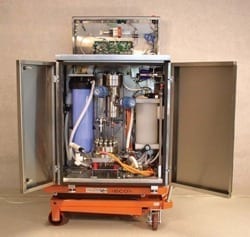
But in laboratory research, they are already a common fixture.
The element hydrogen offers hope and headaches in equal measure. The most abundant element on the planet is also one of the most attractive for use as fuel. But because it is also the lightest element, it does not naturally occur in pure form. Hydrogen is so crucial in manufacturing, energy supply, and scientific research that new methods to improve production are being eagerly sought.
Hydrogen production is difficult. Generating the gas costs more energy than can be recovered from heat in combustion. And containing and storing this highly flammable gas has been a constant challenge as well.
The leading method of production is steam-methane reforming, which extracts hydrogen from methane gas. This is the leading process for generating hydrogen in large quantities, but produces carbon dioxide and carbon monoxide. Electrolysis is the other prevalent method, in which electricity applied to water separates hydrogen and oxygen atoms, yielding pure hydrogen and waste oxygen.
For research laboratories, these options traditionally meant relying on third-party gas producers to generate, store, and deliver hydrogen (and other gases) in tanks to be utilized as needed. This has created a well-established supply network that resembles a variety of petroleum-based fuels.
In recent years, however, electrolysis has emerged as a second option. Proton Onsite, a hydrogen energy and gas provider in Wallingford, Conn., uses electrolysis to manufacture on-site, high-purity gas generators called proton exchange membrane (PEMs) electrolyzers. They work by running a current through a solid polymer electrolyte. This electrolyte is a thin, specialized plastic membrane that is permeable to protons when saturated with water, but does not conduct electrons. The process of electrolysis draws a hydrogen ion (the “proton”) from deionized water and brings it through the membrane. Eventually, a number of ions combine at the other end of the membrane to produce hydrogen gas, leaving oxygen on the opposite side.
The Power of PEM
Electrolysis through proton exchange is not new. NASA first used the technology on a significant scale in its Gemini program in the 1960s. But only recently has PEM technology been looked to by the U.S. government and a variety of major foreign firms, such as Mitsubishi Industries, as the basis for a large-scale energy and transportation infrastructure.
As a result of breakthroughs by federally funded research efforts and the work of private industry, such as Proton Onsite, the market for components of PEMs and membrane electrode assemblies used in PEM fuel cells (PEMFC) is growing. The market analysis firm Transparency Market Research predicts a compounded growth of approximately 21.1% from 2012 to 2018, spurred by a general demand for reduced fossil fuel usage and lower carbon emissions. As the technology improves, major players in the fuel cell component marketplace will increase investments.
The R&D segment of the market now represents about 20% of Proton Onsite’s current business. Due to an array of research applications that need high-purity gas, Proton Onsite has developed a dozen different PEMs to suit applications ranging from liquid chromatography/mass spectrometry to atmospheric analysis.
Proton Onsite’s primary laboratory product is the HOGEN hydrogen generator, which provides ultrahigh-purity hydrogen as a carrier gas with consistent composition and predictable low levels of oxygen and nitrogen. The HOGEN GC hydrogen generator is a simpler, less expensive, and less complex PEM geared for gas chromatography. For larger laboratories, the HOGEN S Series 20 and 40 hydrogen generation systems can supply carrier and fuel gas for up to 200 gas chromatographs.
“Many of our clients work in laboratories and facilities that are engaged in R&D, ranging from analytical chemistry and mechanical engineering to meteorological studies. Essentially, we supply technology for any application that requires a constant, pure supply of hydrogen, nitrogen, or zero air,” says Dave Wolff, regional manager at Proton Onsite.
The growth in laboratory use can be explained by convenience. PEMs can replace the need to procure, manage, and secure traditional sources of delivered gas to the facility. Proton OnSites’ patented PEM electrolysis technology produces hydrogen at 200 psig or higher, without the need for mechanical compression, eliminating the need for high-pressure liquid hydrogen tanks or compressed gas storage.
Scientists and researchers typically require hydrogen with ultrahigh purity. They want the gas for fuel and as a reducing agent.
“The on-site gas generator supplies a benchtop by utilizing water, electricity, and air to produce the gases needed for analytical chemistry applications in most laboratories. Between 8 and 10% of facilities each year are moving from gas generated onsite versus delivered gas in cylinders, as the price for delivered gases continues to increase and on-site generated gas costs remain stable. Also, in the case of helium, which is a dwindling natural resource, on-site alternatives are being considered as the gas becomes scarcer,” says Wolff.
Proton Onsite also helps address a crucial question for laboratories being fitted-out for gas supply: centralized utility infrastructure, or a point-of-use approach?
“There are a lot of factors in deciding whether to opt for several smaller generators or one large centralized system,” says Wolff. “To determine what scale will work best for any R&D application, a facility manager must consider redundancy, security, and safety. A manager must also consider long-term needs for the application in question, as a centralized system would benefit an expanding operation. It’s all about economies of scale, so for a decision like this, foresight and a good grasp of the numbers is always the best tool for weighing the options.”
Another major selling point for Proton Onsite is safety. By producing gas at the point of use, facilities circumvent the potential hassle of handling gas-filled cylinders on a regular basis. These cylinders, which are heavy and, in the case of hydrogen, contain highly flammable gas at 2,200 psi, are frequently viewed as one of the more risk-prone features of a typical laboratory.
“With a gas generator, there is no need to employ people to continuously handle cumbersome and dangerous cylinders, and there are few safety codes to adhere to. I would say the best reason to choose an on-site source of gas is precisely because there is no need for extraordinary design or installation measures,” says Wolff.
The Latest Bing News on:
Hydrogen generators
- Where Will Plug Power Stock Be in 3 Years?on April 27, 2024 at 12:29 am
Plug Power (NASDAQ: PLUG), a developer of hydrogen fuel cell systems, was one of the biggest boom and bust stories of the dot-com bubble more than two decades ago. The company went public at a reverse ...
- 3 energy questions hang over EPA’s carbon ruleon April 26, 2024 at 3:58 am
President Joe Biden's power plant regulation could shift the future of carbon capture, hydrogen and natural gas.
- This legendary brand cracks the code: here’s the most powerful hydrogen fuel cellon April 25, 2024 at 7:29 am
Legendary brand has created the first lightweight hydrogen fuel cell: the most powerful, but the smallest ever seen in history ...
- Column: Here are the 32 coal plants still powering the American Weston April 25, 2024 at 6:00 am
Over the last two decades, 21 coal-fired power plants have shut down across the Western U.S. Twenty-one down, 32 to go. Those numbers are based on a Sierra Club tracker and an L.A. Times analysis.
- Hyliion and BayoTech Partner to Provide Sustainable Power with Hydrogen Hubs and the KARNO™ Generatoron April 25, 2024 at 5:30 am
Hyliion's innovative KARNO generator, which can operate on multiple fuel types including hydrogen, is designed for a variety of applications such as prime power, renewables matching, and for ...
- Hyliion and BayoTech Partner to Provide Sustainable Power with Hydrogen Hubs and the KARNO™ Generatoron April 25, 2024 at 5:30 am
Hyliion Holdings Corp. (NYSE: HYLN) ("Hyliion"), a developer of sustainable electricity-producing technology, and BayoTech, an innovator in hydrogen production, transportation and storage solutions, ...
- Zepher Flight Labs, NovaSpark Energy to Prototype Hydrogen Generators for Austere Environmentson April 23, 2024 at 4:37 pm
Looking for the latest Government Contracting News? Read about Zepher Flight Labs, NovaSpark Energy to Prototype Hydrogen Generators for Austere Environments.
- TV news programme highlights its own carbon useon April 23, 2024 at 4:36 am
R egional television news programme BBC South Today will broadcast a special edition with a focus reducing its own carbon footprint. The programme's outside broadcast segment will be powered by a ...
- Earth Day 2024: Engineer Uses Hydrogen To Save The Internal Combustion Engineon April 22, 2024 at 12:09 pm
To save the Earth and make it a better place for his grandson when he's ready to drive, former GM engineer Mike Copeland has found a way to use hydrogen in old cars.
- Powering tomorrow: What role do diesel generators play in the future of clean energy solutions?on April 19, 2024 at 11:06 pm
Another approach to make current backup power more sustainable is through generator aftertreatment systems. Aftertreatment systems, in a nutshell, are pieces of equipment that can be applied to a ...
The Latest Google Headlines on:
Hydrogen generators
[google_news title=”” keyword=”Hydrogen generators” num_posts=”10″ blurb_length=”0″ show_thumb=”left”]
The Latest Bing News on:
Renewable energy future
- The Future of South Korea’s Nuclear Energy Policyon April 27, 2024 at 3:28 pm
The opposition Democratic Party’s landslide victory in South Korea’s April 10 parliamentary election appears likely to significantly influence the government’s energy policy, particularly regarding ...
- How Do Wind, Solar, Renewable Energy Effect Land Values?on April 26, 2024 at 2:04 pm
Muth says the biofuels industry growth will also effect land values as the production of corn and soybeans is needed for Sustainable Aviation Fuel and renewable diesel. He discusses more about wind, ...
- UFlex switches to renewable energy for packaging plant in Karnataka, Indiaon April 26, 2024 at 9:49 am
The agreement is a Power Purchase Agreement with Amplus Phoenix Private Limited, which will supply clean energy under a group captive power policy.
- Energy Efficiency is Critical for a Sustainable Futureon April 26, 2024 at 9:00 am
Governments must prioritize energy efficiency and reduce energy waste to achieve clean energy security and combat climate change.
- Government to fast-track approvals for energy exploration on public lands: '[It] can move our country toward a clean energy future'on April 26, 2024 at 3:15 am
The energy source supplies just 1% of the States' electricity, but the Department of Energy believes that number could climb as high as 10%.
- A Lofty Future for Wind Energy, but State Goals Are No Breezeon April 25, 2024 at 2:25 pm
Business matters aside, the future is generally bright for offshore wind, leaders said at the 2024 International Partnering Forum for industry. Increasing state energy targets, however, present a ...
- We can preserve Delaware's clean energy future. Keep Delaware Tech's energy programs aliveon April 25, 2024 at 1:09 am
Regarding "Delaware Tech moves to drop renewable energy degree programs," DelawareOnline.com, April 10: Recently, The News Journal published a piece about Delaware Technical Commu ...
- Hawaii’s Ambitious Renewable Energy Plan Is Threatened By HECO’s Uncertain Futureon April 24, 2024 at 5:19 pm
Hawaii’s renewable energy sector is stepping up support for policies aimed at financially bolstering Hawaiian Electric Co., which has been battered by accusations that the utility started the fire ...
- Revolutionizing Renewable Energy: Innovative Salt Battery Efficiently Harvests Osmotic Poweron April 24, 2024 at 5:00 am
A new semipermeable membrane doubles the osmotic energy output in estuaries, showing potential for sustainable power generation. Estuaries — where freshwater rivers meet the salty sea — are great ...
- The future of clean energy hinges on cybersecurityon April 23, 2024 at 11:00 am
In the long term, the energy sector needs coordinated, long-term collaboration to ensure that cybersecurity is a core tenet of clean energy. Close and frequent collaboration between the cybersecurity ...
The Latest Google Headlines on:
Renewable energy future
[google_news title=”” keyword=”fix the internet” num_posts=”10″ blurb_length=”0″ show_thumb=”left”]











